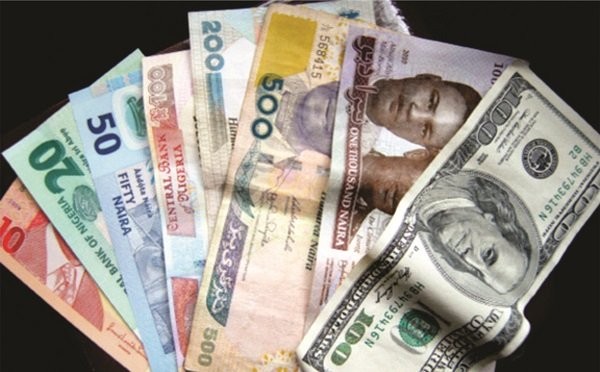Criticisms trail CBN’s policy as naira weakens

The apex bank’s Naira for Dollar Scheme aims at encouraging dollar remittances by paying N5 for every dollar received. The scheme took effect from March 8, 2021 and is scheduled to end on May 8, this year.
Most analysts at the weekend said the scheme amounted to indirect depreciation of naira and a policy somersault, stoking confusion and fears in the forex market.
At the parallel market, the naira depreciated by 1.04 per cent to N485 per dollar, on the same trend with the Bureau De Change (BDC) segment, where naira depreciated by 0.42 per cent to close weekend at N477 per dollar.
However, at the official Investors & Exporters (I & E) window, naira appreciated by 0.24 per cent to close at N410 per dollar amid sustained rise in crude oil prices.
Data provided by Cowry Asset Management showed that naira closed flat at N380.69 per dollar at the Interbank Foreign Exchange market amid weekly injections of $210 million by CBN into the forex market.
A breakdown showed that $100 million was allocated to Wholesale Secondary Market Intervention Sales (SMIS), $55 million was allocated to Small and Medium Scale Enterprises while $55 million was sold for invisibles
Market pundits said the scheme was a “too little attempt” to correct pricing anomalies fostered by policy inconsistencies and lack of clarity. The market saw the naira incentive as a subtle devaluation of the national currency.
“However, we feel that the CBN’s Naira for Dollar Scheme appears to be another form of Naira depreciation which may have sent wrong signal to the forex market,” Cowry Asset Management stated.
Senior Research Analyst, FXTM, Lukman Otunuga said policy somersaults over the past few weeks have fostered a sense of uncertainty.
According to him, although the country remains on a fragile road to economic recovery, a series of policy u-turns over the past few weeks has fostered a sense of uncertainty.
“For an extended period, the International Monetary Fund (IMF) and other major institutions have advised Nigeria to abolish its multiple exchange rates and tame. Indeed, higher oil prices are a welcome development for the economy but without the correct structural reforms, the country remains exposed to external risks,” Otunuga said.
He pointed out that over the past few months, Nigeria has faced persistent dollar shortages, which has weighed heavily on the local currency and stoked inflationary pressures.
“The question is whether this two-month scheme will have the desired effects? Foreign exchange reserves have fallen to $35.23 billion in February from $36.4 billion in January. In regards to inflows from international investors through the Nafex window, this totalled $117.5 million for the first two months 2021 compared to the whopping $3.5 billion for the same period in 2020. As the dollar scarcity rages on, the black market flourishes with the naira depreciating to N485 per dollar compared with the official of N410,” Otunuga said.
He noted that while 2020 was a year defined by extraordinary levels of uncertainty, unprecedented events, and chaos for most economies, 2021 could be one of renewed hope and optimism as COVID-19 rollouts and improving global growth bring back some normality.
“The question is whether Nigeria will be part of the winners that evolve from last year’s chaos or joins the group who are unable to shake of the nasty hangover and negative impacts from 2020,” Otunuga said.
Cordros Capital, a leading investment banking group, said the apex bank’s refusal to “drastically overhaul its foreign exchange policy and allow for proper price determination in the exchange rate is the primary reason for the divergence” between the official and parallel markets, the symptoms of which the scheme aimed at correcting.
According to Cordros Capital, while the apex bank sees the bypassing of official channels partly responsible for the significant disparity between the parallel and official forex rates, thus the Naira for Dollar Scheme, there are many underlying reasons for the flows including the wide disparity between official and parallel rates.
In answering the “fundamental question” of “by how much will the policies on diaspora remittances drive down rates in the parallel market”, Cordros Capital concluded that it would have limited impact in the short to medium term, without any significant rate convergence.
“In estimating how effective the “Naira 4 Dollar Scheme” could be in achieving rate convergence, we wanted to find out how much demand moved to the parallel market in 2020 and how much remittance dollars would be enough to plug the gap.
“We examined the CBN’s pre-pandemic interventions across the different FX windows and compared this to its 2020 interventions. We used the difference between the two periods as a proxy for the parallel market demand.
“On a balance of factors, we think the new policy will have a limited impact in the short-to-medium term. Hence, we do not believe it would lead to any significant rate convergence. Our baseline expectation is for the currency to trade between N450 per dollar and N455 per dollar at the parallel market by the end of the year,” Cordros Capital stated.
According to Cordros Capital, the effective policy measure to encourage remittances through official channels is to unify the exchange rates at the different windows by devaluing the currency towards its fair value.
“The unification is needed to eliminating the parallel market exchange rate premium. Over the long run, the need to diversify the economy’s export base is paramount to solving the exchange rate issues,” Cordros Capital stated. (The Nation)

